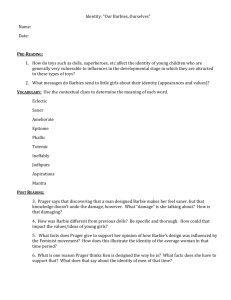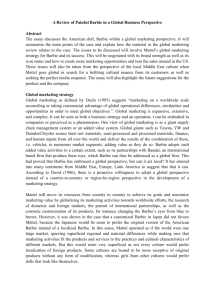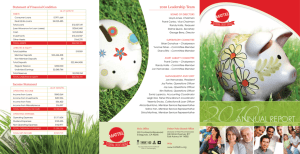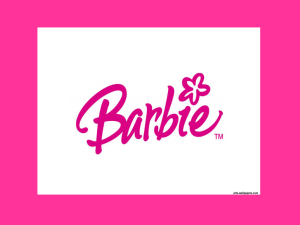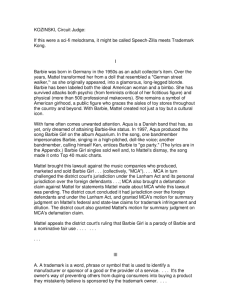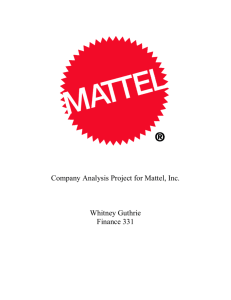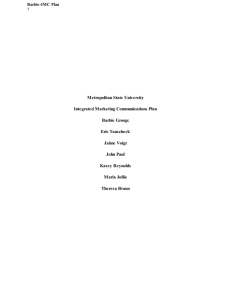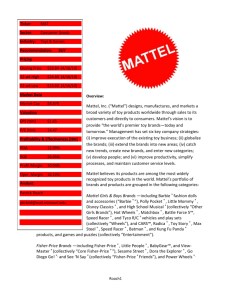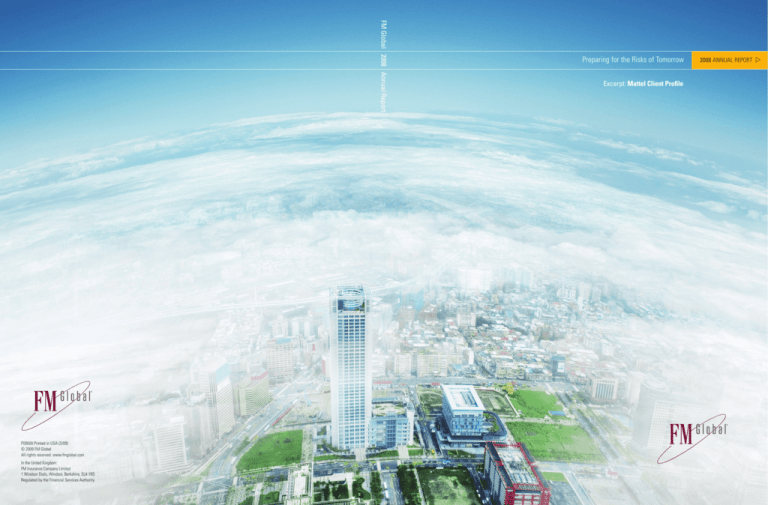
FM Global 2008 Annual Report
P09000 Printed in USA (3/09)
© 2009 FM Global
All rights reserved. www.fmglobal.com
In the United Kingdom:
FM Insurance Company Limited
1 Windsor Dials, Windsor, Berkshire, SL4 1RS
Regulated by the Financial Services Authority.
Preparing for the Risks of Tomorrow
Excerpt: Mattel Client Profile
2008 ANNUAL REPORT
Mattel’s San Bernardino, Calif.,
USA, distribution center is one of
several company facilities where
products are protected by the
Water Protection Unit, visible at
the bottom of all stacks.
Bill Leahy, vice president of U.S. logistics, and Todd Marumoto, director of risk management
Mattel
mattel
Barbie®
One of the most identifiable toys
ever, Barbie® was the creation of
Ruth Handler, a founder of Mattel,
and was named for her daughter,
Barbara. During the past 50 years,
Barbie® has had more than 100
careers, from paleontologist
to presidential candidate.
Mattel, Inc., the number-one toy maker in the world, produces a wide range of products that include
Barbie® dolls, Fisher-Price® toys, Hot Wheels® and Matchbox® cars, along with American Girl® dolls and
licensed items associated with some of the most popular children’s entertainment properties. Established
in 1945 out of a garage workshop in southern California, USA, Mattel started as a family business, and
became enormously successful with the introduction of Barbie® in 1959. In succeeding decades, its product
line continued to expand. The company is committed to its vision to provide “The World’s Premier Toy
Brands—Today and Tomorrow.”
Company size 50 office, manufacturing and distribution facilities in North, Central and South America,
Europe and Asia; 2008 net sales: approximately US$6 billion; number of employees: approximately 30,000
Company type Public
Years with FM Global 24
T
he resilience of Barbie® has been proven
time and again since the iconic doll was
introduced by Mattel 50 years ago. She’s
outlasted many rivals and has kept pace with
technology—even today boasting her own
MP3 player. That resilience was tested in an
unexpected way during a severe storm on
June 1, 2004, when a tornado struck very
close to Mattel’s distribution center in Fort
Worth, Texas, USA. Rain fell so hard that a
corner of the roof collapsed, shearing a sprinkler main over the area where Barbie® dolls
are stored by the millions. When it was over,
a shallow sheet of water covered the floor of
nearly one-third of the building.
Mattel has a unique storage configuration:
Barbie® dolls, like nearly all Mattel products,
are stacked directly on the floor, rather than
on pallets. As water soaked the boxes at the
bottom, entire stacks tilted and collapsed,
toppling onto others, creating what Bill
Leahy, vice president of U.S. logistics, calls
“a huge domino effect” that resulted in a
major claim.
Fortunately, because inventory was available
at other warehouses, customers continued to
find store shelves stocked with their favorite
Barbie® dolls. The loss was a call to action for
Mattel and FM Global, shedding new light on
a critical exposure. Todd Marumoto, director
of risk management, knew additional insurance would not be the answer, saying “the risk
of future business interruption was too great.”
The product had to be better protected, so the
companies formed a team to explore possible
long-term solutions.
After four years of research and testing,
conducted by FM Global in consultation
with Mattel and its broker, Marsh, the team
unveiled the Water Protection Unit (WAPU),
a cover that wraps around the bottom of the
stack, sealing contents from water penetration. The solution worked so well that Mattel
is installing the WAPU at other distribution
centers, where needed—a decision that not
only reduces the cost of insurance, but ensures
Barbie® will be even more resilient as she
stays forever young in the years ahead.
19
In Their Words
Bill Leahy, vice president of U.S. logistics
Todd Marumoto, director of risk management
mattel
After the Fort Worth incident, the potential for loss was no longer a matter of statistics on a page.
This was real—so we were highly motivated to reduce any future exposure.
In every contact I had with FM Global throughout this experience, their number-one concern was
to make sure our business interests were met.
FM Global understood the world from our perspective. That was unique, and something we
appreciated.
In settling the claim, the FM Global team also understood the value and power of brand. We got
into some deep conversations about the type of damage that disqualifies an item from being sold.
We quickly came to the realization that Barbie® can’t be sent to market with her hair askew or her
accessories loose in the box. Even though the box itself might have no visible damage, you can’t
present something that’s less than perfect to a customer.
The ability to have that type of open dialogue, and the respect FM Global showed us, was great
to see. Those aspects of the relationship become more obvious when you have a loss.
In developing the Water Protection Unit (WAPU), a great deal of time and energy was spent on
defining protocol and objectives up front. That made it easier to stay on track as a team, because we
could always look back to the protocol to guide us.
FM Global’s objectivity was refreshing. When exploring solutions, everyone involved—from our
organization, FM Global, and Marsh as well—respected the science. We knew we would be dealing
with facts, not fears or preconceived notions.
We also enjoyed working with, and respected, one another. Nobody led with their specific agenda.
Because it is a significant investment, our plan is to continue to purchase and install more WAPUs
over time, so that we can disburse them among our distribution centers.
After a loss of this size, it would have been easy for FM Global to bid farewell and move on, or
to have insisted on a timetable for installation that would be difficult for us to meet. We didn’t see
any of that. They are in it for the long haul, with the presumption that we would make this partnership
stronger and more effective, with less risk, in the future.
When we host tours for our retail clients, we tell the story of the WAPU. Some of them have
similar issues, and it’s worth knowing that, with the right advice, we don’t have to live with the risk.
20
HOT WHEELS®
Mattel’s Hot Wheels®, which debuted in
1968, have fans of all ages. The average
serious collector owns more than 1,500
cars. With 10,000 models in existence
(many of them retired), collecting
Hot Wheels® could easily be a
lifetime pursuit.


